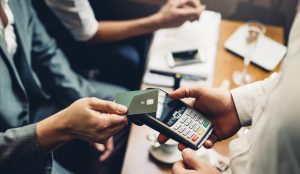We are increasingly moving to a cashless society. First, it was the chequebook, then came debit cards. But even this system has gone through several changes. Chip & Pin technology replaced signature slips as recently as 2004. Now, a new system is in place for smaller transactions. Known as “Contactless Payment”, any transaction under the value of £30 requires simply placing one’s card against the machine. That is it – nothing else is required. The information is transmitted digitally and checked in the same way as Chip & Pin. People are always concerned about new technologies. Contactless Payment is no different. Several myths about this technology are misleading consumers.
Myth: It’s Easy for People to Steal Money from My Contactless Card
As anyone who has ever made a payment by this method knows, it requires very close contact. A few millimetres away is enough of a difference between a relevant machine being able to read your card and not registering the payment. Not only that, but it also requires you to hold your card long enough against the machine for the payment to go through. It’s usually 1-2 seconds. This may not seem like much, but this contact must be sustained. There are reports on the internet about a fraudster walking along a train carriage with a machine taking details from every person present. They would be nowhere near close enough to take details.
Myth: Fraudsters Can Steal Personal Data
Similar to above, it requires very close contact for a long period of time for any fraudster to take your personal details. Even if they could get close enough to you for long enough, the only information they will be able to obtain from your card is that which they can read from the physical card – the number and expiry date. They cannot obtain your bank account data, name and address or even the security code. The actual physical card is more of a threat for loss of this data. Therefore, even if somebody wanted your details to buy goods and services online, they won’t have this failsafe information that web retailers require you to enter.
Myth: I Can Accidentally Pay for Somebody Else’s Shopping
The arrival of self-service machines with unmanned card readers has led to concerns about walking past shoppers about to make payments and your card being read instead of their card. For some, accidental payments are more of a concern than fraud because of the checks and balances for our bank accounts. As already discussed, the distance from your card to the machine is protection enough – your card needs to be within 1-2cm (less than one inch) away from the machine. Even if the distance isn’t enough of a barrier, the leather or plastic of your wallet or purse is.
Myth: A Lost Card Means Emptied Bank Account
Your bank has checks and balances in place to protect against web sales (see above). When shopping in person, it’s certainly possible for somebody to pay for food and drink with your contactless card, but please remember the £30 limit. It will take considerable time to rack up contactless payments over the course of a day. Also, our cards have a system to flag anomalous transactions to the bank who will them immediately put a stop to any further transactions. 10 separate transactions of £30 in one day at supermarkets will qualify as anomalous. By which time, you should have noticed your missing card and reported it anyway. Anyone wanting to empty your bank account with contactless payments will soon find it inefficient and an incredible waste of their time. So long as you report your card stolen, it will not be usable; any money taken will be refunded.
